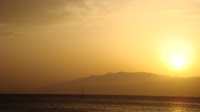A la espera de vuestras preguntas, aquí os dejo una nueva entrada sobre mis últimas vacaciones de verano en San José, un pequeño pueblo perteneciente al Parque Natural Cabo de Gata-Níjar.
El Parque Natural Cabo de Gata-Níjar está situado en el litoral mediterráneo de la provincia de Almería (Andalucía) y es un parque natural marítimo-terrestre de carácter semiárido único en el mundo.
Sus 50 kilómetros perfectamente conservados de costa acantilada ofrecen al visitante la posiblidad de disfrutar de numerosas playas y calas de una belleza extraordinaria. Nosotros estuvimos en las playas de Los Genoveses, Mónsul, San Miguel, Isleta del Moro y Agua Amarga. El baño en aguas cristalinas y unas puestas de sol increíbles están asegurados.
 Otros lugares de interés son el faro de Cabo de Gata, el castillo de los Escullos y la localidad de San Miguel. Y estés donde estés, la oferta gastronómica es enorme y para todos los gustos. Nosotros comimos desde la típica paella de mariscos hasta toda clase de pescados, ensaladas y pizzas. Riquísimo.
Otros lugares de interés son el faro de Cabo de Gata, el castillo de los Escullos y la localidad de San Miguel. Y estés donde estés, la oferta gastronómica es enorme y para todos los gustos. Nosotros comimos desde la típica paella de mariscos hasta toda clase de pescados, ensaladas y pizzas. Riquísimo.Y lo que más nos sorprendió fue el cielo de noche. En mi vida había visto tantas estrellas juntas y tan cerca de nosotros que casi podíamos tocarlas con las
manos. Pero lo mejor es que lo veáis con vuestros ojos y visitéis este Parque Natural “de película”. Y nunca mejor dicho, porque muchos de los “Spaguetti Western” de Sergio Leone, con un jovencísimo vaquero llamado Clint Eastwood, fueron rodados en este parque durante los años 60.
Hola again!
Waiting for your questions and comments, here you have a new post about my last summer holidays in San José
The Natural Park Cabo de Gata-Níjar is located in the Mediterranean coast of the province of Almeria (Andalusia) and it is a maritime-terrestrial Natural Park
50 Km of abrupt coasts, offer the visitors a big number of wonderful beaches and calas. We were at the beaches of Los Genoveses, Mónsul, San Miguel, Isleta del Moro and Agua Amarga. The swim into clear water and wonderful sunsets are guaranteed.
Another places to visit are the Lighthouse of Cabo de Gata, the castle of Los Escullos
The sky by night was amazing. I’ve never seen such a proper night sky, with so many stars and so near that we almost touched them.
But the best is that you visit this Natural Park


